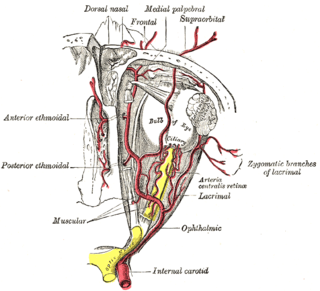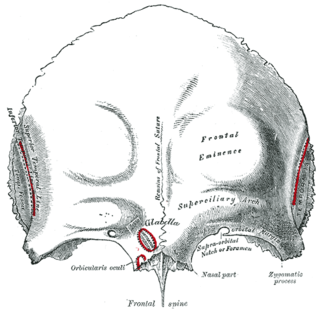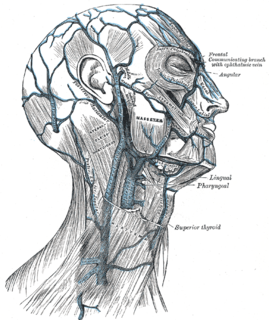
In human anatomy, the forehead is an area of the head bounded by three features, two of the skull and one of the scalp. The top of the forehead is marked by the hairline, the edge of the area where hair on the scalp grows. The bottom of the forehead is marked by the supraorbital ridge, the bone feature of the skull above the eyes. The two sides of the forehead are marked by the temporal ridge, a bone feature that links the supraorbital ridge to the coronal suture line and beyond.

The supraorbital nerve is a terminal branch of the trigeminal nerve.

The scalp is the anatomical area bordered by the human face at the front, and by the neck at the sides and back.

In anatomy, the orbit is the cavity or socket of the skull in which the eye and its appendages are situated. Anatomical term created by Gerard of Cremona. "Orbit" can refer to the bony socket, or it can also be used to imply the contents. In the adult human, the volume of the orbit is 30 millilitres, of which the eye occupies 6.5 ml. The orbital contents comprise the eye, the orbital and retrobulbar fascia, extraocular muscles, cranial nerves II, III, IV, V, and VI, blood vessels, fat, the lacrimal gland with its sac and nasolacrimal duct, the eyelids, medial and lateral palpebral ligaments, check ligaments, the suspensory ligament, septum, ciliary ganglion and short ciliary nerves.

The ophthalmic artery (OA) is the first branch of the internal carotid artery distal to the cavernous sinus. Branches of the OA supply all the structures in the orbit as well as some structures in the nose, face and meninges. Occlusion of the OA or its branches can produce sight-threatening conditions.

The brow ridge, or supraorbital ridge known as superciliary arch in medicine, refers to a bony ridge located above the eye sockets of all primates. In Homo sapiens sapiens the eyebrows are located on their lower margin.

In human anatomy, the superficial temporal artery is a major artery of the head. It arises from the external carotid artery when it splits into the superficial temporal artery and maxillary artery.

The occipitofrontalis muscle is a muscle which covers parts of the skull. It consists of two parts or bellies: The occipital belly, near the occipital bone, and the frontal belly, near the frontal bone. In humans, the occipitofrontalis only serves for facial expressions.

The supraorbital gland is a type of lateral nasal gland found in some species of marine birds, particularly penguins, which removes sodium chloride from the bloodstream. The gland's function is similar to that of the kidneys, though it is much more efficient at removing salt, allowing penguins to survive without access to fresh water. Contrary to popular belief, the gland does not directly convert saltwater to freshwater. The term supraorbital refers to the area just above the eye socket.

The supraorbital foramen, is a bony elongated opening located above the orbit and under the forehead. The supraorbital foramen lies directly under the eyebrow. Sometimes this foramen is incomplete and is then known as the supraorbital notch.

In human cranial neuroanatomy, the supratrochlear nerve is a branch of the frontal nerve, which itself comes from the ophthalmic division of the trigeminal cranial nerve. It is smaller than the nearby supraorbital nerve. It passes above the pulley of the superior oblique muscle, and gives off a descending filament that joins the infratrochlear branch of the nasociliary nerve.

The frontal vein begins on the forehead in a venous plexus which communicates with the frontal branches of the superficial temporal vein. The veins converge to form a single trunk, which runs downward near the middle line of the forehead parallel with the vein of the opposite side. The two veins are joined, at the root of the nose, by a transverse branch, called the nasal arch, which receives some small veins from the dorsum of the nose. At the root of the nose the veins diverge, and, each at the medial angle of the orbit, joins the supraorbital vein, to form the angular vein. Occasionally the frontal veins join to form a single trunk, which bifurcates at the root of the nose into the two angular veins.

The supraorbital vein begins on the forehead where it communicates with the frontal branch of the superficial temporal vein.

The superficial temporal vein is a vein of the side of the head. It begins on the side and vertex of the skull in a network of veins which communicates with the frontal vein and supraorbital vein, with the corresponding vein of the opposite side, and with the posterior auricular vein and occipital vein. It ultimately crosses the posterior root of the zygomatic arch, enters the parotid gland, and unites with the internal maxillary vein to form the posterior facial vein.

There are two surfaces of the squamous part of the frontal bone: the external surface, and the internal surface.

A frontal eminence refers to one of two rounded elevations on the frontal bone that lie about three centimeters above the supraorbital margin on each side of the frontal suture.

The supraorbital artery is an artery of the head.

The supratrochlear artery, one of the terminal branches of the ophthalmic artery, branches off where the ophthalmic artery travels posterior to the trochlea.

Chiloscyllium is a genus of sharks in the family Hemiscylliidae.
Zaraapelta is an extinct genus of herbivorous ankylosaurid thyreophoran dinosaur from the Late Cretaceous of Mongolia. The type species is Zaraapelta nomadis, named and described by Arbour et alii in 2014. Zaraapelta is known from a single skull from the Barun Goyot Formation. It was found to be closest to Tarchia in the phylogenetic analysis within its description.













